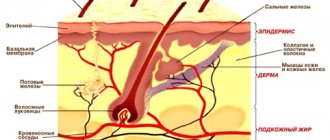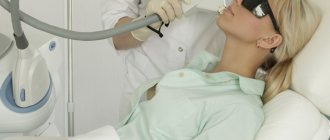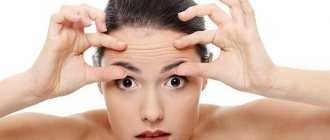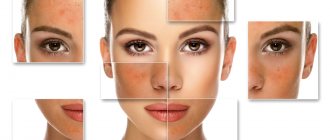Peculiarities
Let's find out what a diode laser is? Today this is the most modern and safe device in the line of lasers for hair removal.
The wavelength of the diode laser beam (800-940 nm) is selected so that it is absorbed by the pigments of the hairs located under the skin, while other skin tissues are not affected. Therefore, the laser hair removal procedure with this laser is the most gentle and effective at the moment.
The “target” of the laser beam becomes the hair root, namely the cells responsible for hair growth. Under the influence of the laser, they heat up and stop working, which is why, as a result of the procedures, hair growth stops almost forever.
This type of laser generates about two pulses per second in duration.
This is interesting ! Cosmetologists of Ancient Egypt knew different methods of hair removal; recipes for hair removal creams based on honey, beeswax and medicinal plants were found. Hair was also plucked and shaved.
Principle of operation
To understand where photons come from, consider the process of recombination (the disappearance of a pair of free carriers - an electron and a hole). When direct voltage is applied to the pn junction of the diode, injection occurs, i.e. a sharp increase in the concentration of nonequilibrium carriers. During the injection process, electrons and holes moving towards each other recombine, releasing energy in the form of a particle - a photon and a quasiparticle - a phonon. This is how the spontaneous emission observed in LEDs occurs.
In the case of a laser diode, instead of a spontaneous one, it is necessary to launch the mechanism of stimulated emission of photons with the same parameters. To do this, an optical resonator is formed from the crystal, passing through which a photon with a given frequency forces the electronic carriers to recombine, which contributes to the appearance of new photons of the same polarization and phase. They are called coherent.
In this case, laser lasing is possible only in the presence of an excessively large number of electron carriers at the upper energy level, released as a result of injection. To do this, use a pump current of such strength as to cause an inversion of the electron populations. This phenomenon refers to a state in which the upper level is much more populated by electrons than the lower one. As a result, the emission of coherent photons is stimulated.
Further, such photons are repeatedly reflected from the edges of the optical resonator, triggering the launch of positive feedback. This phenomenon is of an avalanche-like nature, as a result of which a laser beam is born. Thus, the creation of any optical generator, including a laser diode, requires the fulfillment of two conditions:
- presence of coherent photons;
- organization of positive optical feedback (POF).
To prevent the formed beam from scattering due to diffraction, the device is equipped with a collecting lens. The type of lens installed depends on the type of laser.
Who is recommended for diode laser hair removal?
The desire to look good and feel confident in any situation is a good reason to undergo hair removal with a diode laser. Indications for the use of this type of hair removal may be:
- naturally dark skin, for which photoepilation and hair removal with an alexandrite laser are not suitable;
- skin prone to hyperpigmentation and freckling;
- ingrown hairs and other side effects when removing hair with wax or other methods;
- hair that is naturally coarse and difficult to respond to other hair removal methods;
- hair removal on the face and other delicate areas of the body.
This is interesting !
Laser hair removal appeared in the 70s of the twentieth century as a result of an accidental discovery. An American physicist was the first to test the ability of a laser to stop the growth of body hair. The result of “elimination” of unwanted hairs with a diode laser in the photo (before and after).
What is diode laser hair removal?
Diode laser hair removal (DLE) is one of the most advanced hair removal methods available today. The principle of its operation is quite simple. The heat released during the beam's flashes destroys the follicle and hair shaft. It, in turn, stops growing temporarily or forever, depending on the degree of damage to the root system.
Some of the vegetation disappears from the treated area after the first procedure. However, additional sessions will be required in any case. The diode laser destroys only those hairs that are in the active phase. There are about a quarter of these on the human body. As soon as the device destroys the follicles of some, another part of the hair will begin to grow - and so on until all the follicles have been processed.
Melanin gets the most damage when fighting vegetation with DLE. The light impulse is converted into heat only in the pigment cells. That is why the pain from the procedure, although it depends on the person’s skin type and sensitivity, is still minimal.
The need to reach melanin cells also determines the types of appearance suitable for manipulation. The diode laser works best with contrasting colors of skin and hair - with a combination of very light skin and dark hair on the body.
From the video you can learn more about the principle of operation of a diode laser, the advantages of devices of different generations, and listen to a review from a person who has already undergone several hair removal procedures.
Advantages
The use of a diode laser for hair removal, according to experts, is becoming the most popular method of hair removal, because it has the following advantages:
- Durability and aesthetics of the result. After the session, the hairs simply fall out painlessly and without a trace, slight redness goes away within 24-48 hours. There is no effect of coarser and darker hair growing back after the procedure. Hairs do not grow in and do not become inflamed.
- Speed of the procedure. The cosmetologist performs manipulations literally “at the speed of light”; the device quickly moves across the skin, which makes it possible to treat fairly large areas in a short time.
- Precision and versatility. A diode laser for hair removal targets a local area of skin with a beam of light, which allows you to model the contours of hair growth. The diode laser is suitable for hair removal of almost all skin types; it can be used by patients with dark and freckled skin.
- The radiation power of the diode laser must be selected in accordance with the patient’s skin type.
- Painlessness and rapid skin regeneration after the procedure in comparison with other methods of hair removal. During the procedure, a gel is used for light anesthesia. The design of the device provides cooling of the instrument and skin during the procedure. The patient usually feels a tingling sensation in the area affected by the laser
- Safety – mechanical damage to the skin and hair follicle is excluded, so it is impossible to introduce an infection into the body during the procedure. If all skin care rules are followed after a diode laser hair removal procedure, side effects are minimal and the results are as long as possible.
Learn about the advantages of a diode laser and how it differs from other lasers for hair removal in this video.
Important ! Observe restrictions on sun exposure before and after the procedure, this will make it more effective.
Types of lasers
In total, there are four main types of lasers for hair removal, which are actively used by masters in their beauty salons:
- Diode. The most popular laser for hair removal of any type.
- Ruby. Low efficiency of follicle removal, impossibility of performing the procedure on light hair. The advantage is the low price of the service;
- Alexandrite. In terms of functionality it is closer to a diode laser, but there is a possibility of getting burned.
- Neodymium. The procedure is quite painful; complete hair removal in a certain area requires multiple visits to the salon;
But diode laser hair removal also has its own varieties. In addition to the so-called “classic” - dark hair removal, there are other varieties.
- Elos hair removal. Removing blonde hair. The procedure is painful and expensive.
- Laser cool hair removal. The most effective and safe procedure. Rarely used in beauty salons because it requires highly qualified workers.
Reviews from patients who have undergone the procedure indicate that the best results are obtained by combining classic hair removal and elos hair removal.
Popular diode laser models:
- MeDioStar;
- D-Las;
- DiodIV;
- LightSheerET;
- AnchorFree;
- DUFLEX;
- SopranoXL;
- ADSS.
Advantages and disadvantages of diode laser
Each hair removal option with these lasers has its own advantages and disadvantages. The newest, actively gaining popularity, is the diode laser. And although the procedure is not as painless as its advertisement says, reviews about it are very positive.
Advantages of a diode laser:
- The same effect works with hair of any type and color.
- Possibility of hair removal on tanned skin.
- Painless procedure.
- Safe removal of unwanted hair.
- Complete baldness of the desired area occurs after 4-6 laser therapy sessions.
- No redness, skin irritation, thermal burns.
- The maximum procedure time is 60 minutes.
- Most follicles are permanently affected from the first session.
- Removes blackheads on the chin that appear after shaving.
Minuses:
- Epilation of tanned skin is less effective than light skin.
- Light hair requires much more treatment sessions than dark hair.
- High cost of the procedure.
- Unpleasant sensations during the procedure (mild pain).
The pain of the procedure also depends on the area where the procedure is performed. The skin on the face is thinner, and the nerve endings are located close to each other, making the procedure somewhat unpleasant. But only small pricks are felt on the legs or in the bikini area.
Contraindications and disadvantages of diode laser
Before performing hair removal with a diode laser, the cosmetologist is obliged to tell the patient about contraindications, clarify his state of health and the absence of allergic reactions.
Temporary contraindications:
- Inflammatory processes, injuries and burns at the procedure sites.
- Exacerbation of chronic diseases.
- A tan.
Breastfeeding and expectant mothers do not undergo laser hair removal procedure; this is due to hormonal processes in the woman’s body.
Permanent contraindications:
- Diabetes,
- Diseases of the thyroid gland, cardiovascular system, and pelvic organs.
- Oncological diseases
- Varicose veins and other vascular pathologies in the hair removal area.
If increased hair growth is caused by hormonal imbalances in the body, laser hair removal may not be effective.
This method is also ineffective for removing colorless and gray hair. A neodymium laser is used for this.
Preparation before the procedure
For successful hair removal with a diode laser, the following preparation is needed:
- 1.5-2 months before the procedure, you should not use depilatory creams or remove hair with wax, sticky strips or tweezers.
- The procedure is carried out on untanned skin; at least 10 days must pass from the moment of exposure to the open sun.
- A day or two before the session, you need to shave the hair in the epilation area, the permissible hair length is 1-1.5 mm and do not apply any creams or deodorants to the skin for 24 hours.
Information ! For complete disappearance of hair, it may take from 2 to 5-7 sessions. This depends on the individual characteristics of the patient and the care of the hair removal area after the procedure.
Skin care after the session
Immediately after the session, the cosmetologist treats the skin at the epilation site with a professional product that contains cooling components, panthenol, and vitamins.
To care for the hair removal area after 2-3 hours, you can use panthenol and light moisturizers. Read more about skin care after laser hair removal to achieve the best results.
After the procedure it is not recommended:
- take a hot shower or bath for a day, actively engage in sports;
- 10-12 days of sunbathing and visiting a solarium, infrared sauna, and steam bath.
Information ! The body's individual reaction to the procedure, the rate of hair loss and regrowth may vary from patient to patient.
Areas and cost of the procedure
In cosmetic clinics, prices for diode laser hair removal depend on the part of the body on which the procedure is performed. The range of prices for treatment of one zone in one salon depends on the density of hair growth in the patient.
- full face – 3000-4000 rub.
- upper lip – 1200-1300 rub.
- ears, cheeks, chin 900-100 rubles. for 1 zone.
- neck – back and front surface 2000 RUR each.
- full legs -10,000-11,000 rub.
- drumsticks – 6000-7000 rub.
- bikini area along the lingerie line – 2500 – 3000 rub.
- total bikini from 6000 rub.
- armpits -1200-2000 rub.
Many salons hold loyalty promotions for new and regular customers and offer seasonal discounts.
Types of laser diodes
Over the years of development, the laser diode device has undergone many changes. Its design has been improved, largely thanks to the advent of high-tech equipment. The highest precision of doping and polishing of the semiconductor crystal, as well as the creation of a heterostructural model, are the factors that ensured a high reflection coefficient at the crystal-air interface and the formation of coherent radiation.
The first laser diode (diode with a homostructure) had one pn junction and could operate exclusively in pulsed mode due to rapid overheating of the crystal. It has only historical significance and is not used in practice.
A laser diode with a double heterostructure (DHS diode) turned out to be more efficient. Its crystal is based on two heterostructures. Each heterostructure is a material (gallium arsenide and aluminum gallium arsenide) with a low bandgap, which is located between layers with a larger bandgap. The advantage of a GVD laser diode is a significant increase in the concentration of oppositely polar carriers in a thin layer, which significantly accelerates the manifestation of positive feedback. In addition, the reflection of photons from heterojunctions leads to a decrease in their concentration in the low gain region, and therefore increases the efficiency of the entire device.
A quantum well laser diode is designed on the principle of a GVD diode, but with a thinner active region. This means that elementary particles, falling into such a potential well, begin to move in the same plane. The quantization effect in this case replaces the potential barrier and serves as a radiation generator.
The insufficient efficiency of light flux confinement in DGS diodes led to the creation of a heterostructure laser with separate confinement. In this model, the crystal is additionally covered with a layer of material on each side. Despite the lower refractive index of these layers, they confidently retain particles, acting as a light guide. SCH technology occupies a leading position in the production of diode lasers.
Distributed feedback (DFB) laser diode is a part of optical equipment in the field of telecommunications systems. The wavelength of the DFB laser is constant, which is achieved by applying a transverse notch to the semiconductor in the region of the pn junction. The notch performs the function of a diffraction grating, thereby returning photons with only one (specified) wavelength to the resonator. These coherent photons are involved in amplification.
A surface-emitting laser diode with a vertical resonator or a vertically emitting laser VCSEL, unlike the previously discussed devices, emits a beam of light perpendicular to the surface of the crystal. The VCSEL design is based on the method of using vertical optical microcavities with mirrors, as well as achieving the GVD and quantum well techniques. The advantage of VCSEL technology is temperature and radiation stability, the possibility of group production of crystals and their testing directly at the manufacturing stage.
A modification of the VCSEL is a VCSEL with an external resonator (VECSEL). Both laser diodes are positioned as high-speed devices with the ability to provide future data transmission at speeds of up to 25 Gbit/s via fiber optic communications.











